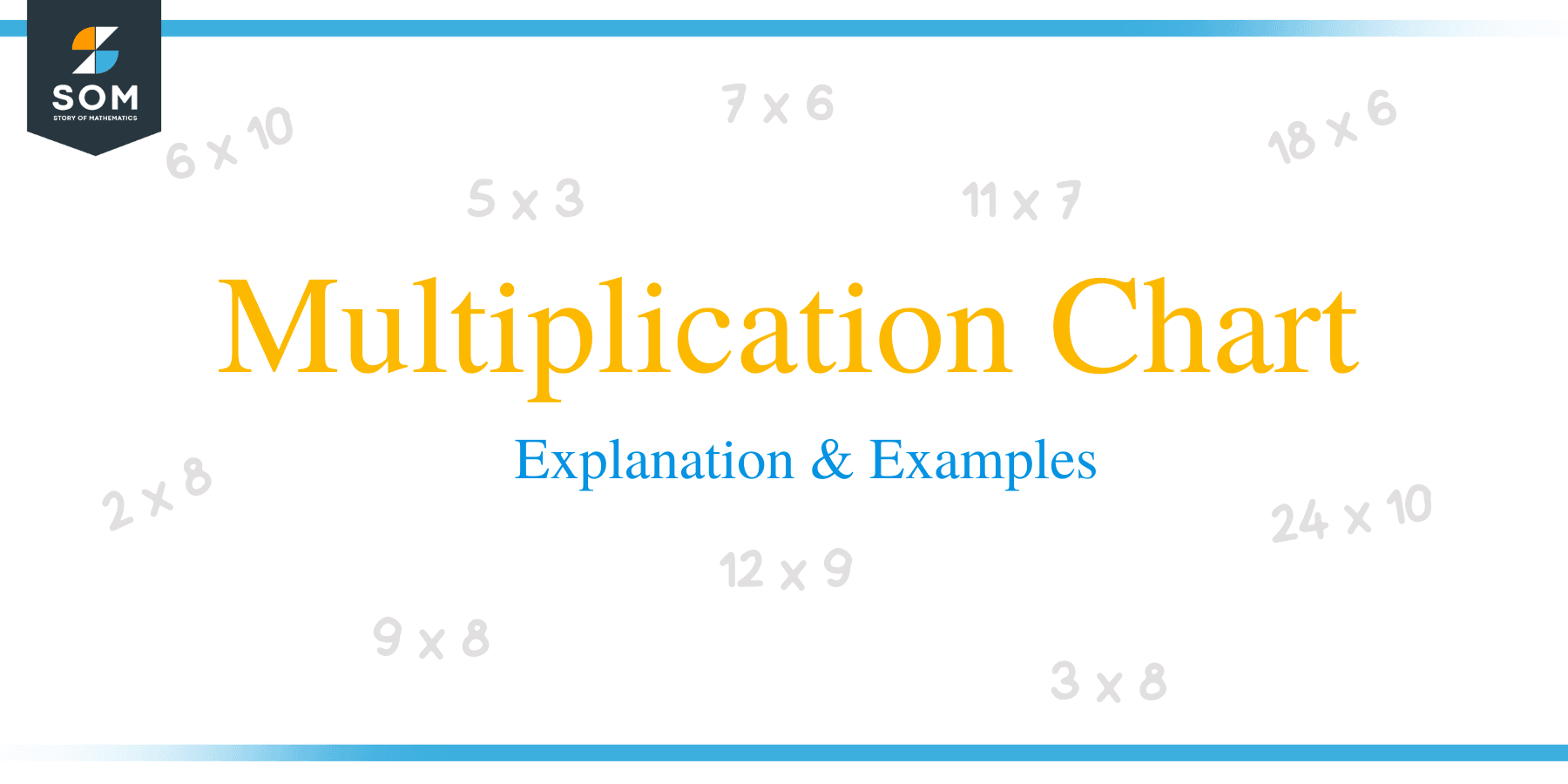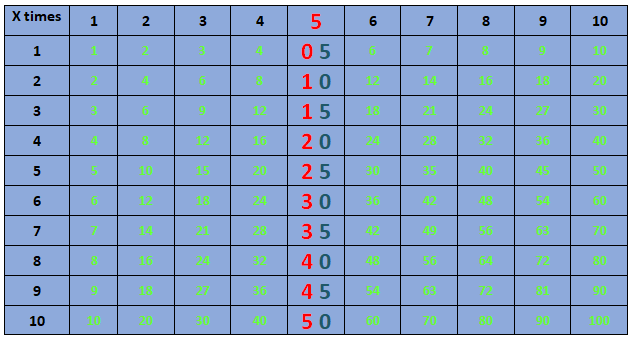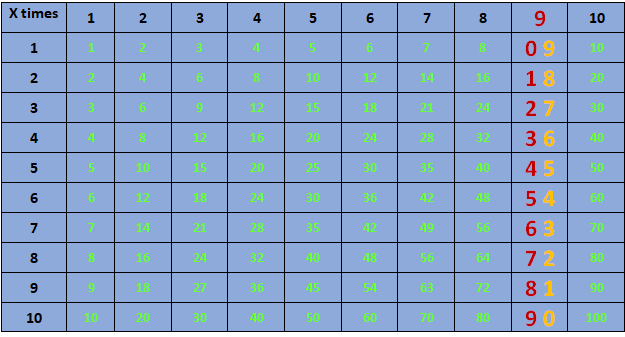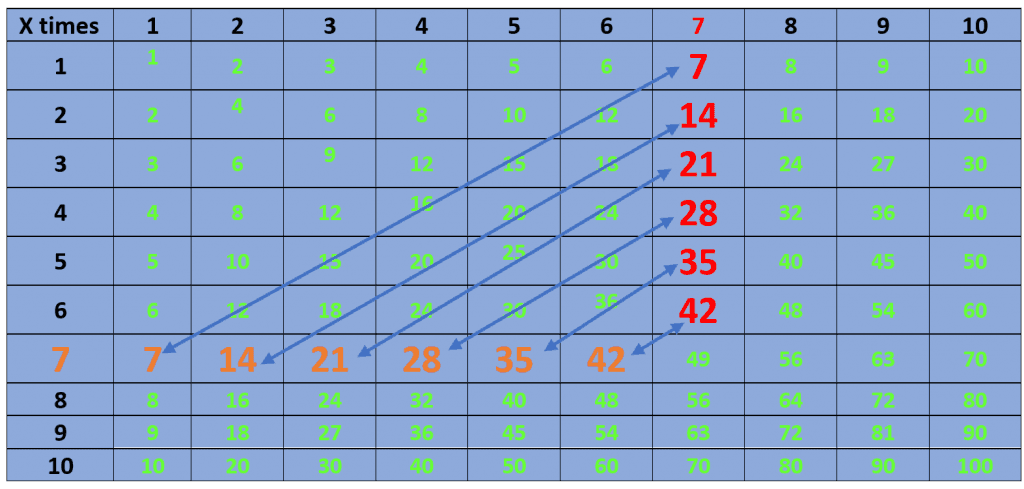- Home
- >
- Multiplication Chart – Explanation & Examples
JUMP TO TOPIC
Multiplication Chart – Explanation & Examples
 A Multiplication Chart is a list of multiplication tables from 1 to 10. Understanding and memorizing multiplication tables is essential for solving mathematical problems related to multiplication, fraction, division, and basic algebra. This chart is useful in understanding the basics of multiplication.
A Multiplication Chart is a list of multiplication tables from 1 to 10. Understanding and memorizing multiplication tables is essential for solving mathematical problems related to multiplication, fraction, division, and basic algebra. This chart is useful in understanding the basics of multiplication.
Multiplication Chart is a table that contains the first 10 multiples of the numbers from 1 to 10.
Familiarizing themselves with the multiplication chart will help students master using the multiplication tables. The chart also shows some patterns that certain tables follow, and these patterns can help students learn the tables faster.
It is advisable to refresh the following concepts to understand this topic easily.
- Multiplication
- At least two to three multiplication tables
Multiplication Table
The multiplication table of the multiplication chart contains the first 10 multiples of the numbers from 1 to 10. In this table, the left-most column consists of the first 10 natural numbers in ascending order. Similarly, the topmost row also consists of the first 10 natural numbers in ascending order.
The rest of the boxes consist of the products of the two natural numbers, i.e., one number from the top row and the second number from the left-most column. For example, the box showing the number 4 (in blue color) is the product of the number 2 from the topmost row and the number 2 from the left-most column ( $2\times 2 = 4$).
| X times | 1 | 2 | 3 | 4 | 5 | 6 | 7 | 8 | 9 | 10 |
| 1 | 1 | 2 | 3 | 4 | 5 | 6 | 7 | 8 | 9 | 10 |
| 2 | 2 | 4 | 6 | 8 | 10 | 12 | 14 | 16 | 18 | 20 |
| 3 | 3 | 6 | 9 | 12 | 15 | 18 | 21 | 24 | 27 | 30 |
| 4 | 4 | 8 | 12 | 16 | 20 | 24 | 28 | 32 | 36 | 40 |
| 5 | 5 | 10 | 15 | 20 | 25 | 30 | 35 | 40 | 45 | 50 |
| 6 | 6 | 12 | 18 | 24 | 30 | 36 | 42 | 48 | 54 | 60 |
| 7 | 7 | 14 | 21 | 28 | 35 | 42 | 49 | 56 | 63 | 70 |
| 8 | 8 | 16 | 24 | 32 | 40 | 48 | 56 | 64 | 72 | 80 |
| 9 | 9 | 18 | 27 | 36 | 45 | 54 | 63 | 72 | 81 | 90 |
| 10 | 10 | 20 | 30 | 40 | 50 | 60 | 70 | 80 | 90 | 100 |
Significance of the Multiplication Chart
Students should take a printout of the multiplication chart as it will help them in memorizing multiplication tables. It will aid students in identifying certain patterns in different tables, which are quite handy in learning and memorizing those tables. Let us discuss some patterns and tips which can be identified using a multiplication chart.
- In the 2 times table, each number is increased by 2. For example, $2\times 1 = 2$, so if we add 2 with 2, we get $2+2 = 4$, which is equal to $2\times 2$. Similarly, if we add 2 with 4, we get $2+4 = 6$, which is equal to $2 \times 3$ .This is the pattern that can be identified easily using a multiplication chart.
- Each number ends with either a 5 or a zero in the 5 times table, as shown in the picture below.

This pattern will help students memorize the 5 times table quickly.
- In the 9 times table, the tens place digit of the last (i.e., 10th) multiple starts with a zero and keeps on increasing by one number. As the multiples move from 10 to 1, the tens digit of the product increases from 0 to 9, as shown in the picture below.

- The 10 times table has a zero at the tens place of each multiple, while the unit place of each multiple consists of the natural numbers in ascending order.
- The 7 times table is one of the trickiest and hardest tables to memorize. The multiplication chart helps in memorizing the first six multiples of 7. As we can see in picture below, $1\times 7 = 7\times 1$. Similarly, $5\times 7 = 7\times 5$. So, by using the previous tables, students can memorize almost half of the 7 times table in no time.

Tips To Learn the Multiplication Tables More Quickly
- Identifying the patterns: Students should identify and use the patterns discussed above to memorize the tables quickly.
- Learning in bits and pieces: Students should learn the table in bits and pieces. For example, students should target the first five tables first. Learning in chunks will help the students in memorizing the tables quickly and easily.
- Printing the multiplication chart: Students should print the multiplication chart and carry the chart with them. Periodic reading and observing the chart will help the students memorize the table quickly.
- Reciting the tables: Students should read the tables loud and clear and repeat the process; this method will help students memorize the difficult tables.
- Writing practice: Students should make a habit of writing the tables. The writing process has proved effective in memorizing stuff quickly.
- Applying multiplication in real life: Real-life experiences can be used to learn and memorize multiplication tables. For example, Allan receives 2 dollars daily as pocket money. Allan can use the multiplication tables to calculate the total amount of pocket money per week, i.e., $2\times 7 = 14$ dollars.
Maths Table from 1 to 24
Multiplication tables form the basis in terms of understanding multiplication and division in mathematics. If students have a strong grip on the multiplication tables, they will find it easy to solve basic multiplication and division problems. The multiplication tables from 1 to 24 are given below.
Table of 1 to Table of 4 | |||
1 Times Table | 2 Times Table | 3 Times Table | |
$1\times 1 = 1$ | $2\times 1 = 2$ | $3\times 1 = 3$ | $ 4 \times 1 = 4$ |
$1\times 2 = 2$ | $2\times 2 = 4$ | $3\times 2 = 6$ | $4 \times 2 = 8$ |
$1\times 3 = 3$ | $2\times 3 = 6$ | $3\times 3 = 9$ | $4 \times 3 = 12$ |
$1\times 4 = 4$ | $2\times 4 = 8$ | $3\times 4 = 12$ | $4 \times 4 =16$ |
$1\times 5 = 5$ | $2\times 5 = 10$ | $3\times 5 = 15$ | $4 \times 5 =20$ |
$1\times 6 = 6$ | $2\times 6 = 12$ | $3\times 6 = 18$ | $4 \times 6 =24$ |
$1\times 7 = 7$ | $2\times 7 = 14$ | $3\times 7 = 21$ | $4 \times 7 = 28$ |
$1\times 8 = 8$ | $2\times 8 = 16$ | $3\times 8 = 24$ | $4 \times 8 = 32$ |
$1\times 9 = 9$ | $2\times 9 = 18$ | $3\times 9 = 27$ | $4 \times 9 = 36$ |
$1\times 10 = 10$ | $2\times 10 = 20$ | $3\times 10 = 30$ | $4 \times 10 = 40$ |
Table of 5 to Table of 8 | |||
| 6 Times Table | 7 Times Table | ||
$5\times 1 = 5$ | $6\times 1 = 6$ | $7\times 1 = 7$ | $ 8 \times 1 = 8$ |
$5\times 2 = 10$ | $6\times 2 = 12$ | $7\times 2 = 14$ | $8 \times 2 = 16$ |
$5\times 3 = 15$ | $6\times 3 = 18$ | $7\times 3 = 21$ | $8 \times 3 = 24$ |
$5\times 4 = 20$ | $6\times 4 = 24$ | $7\times 4 = 28$ | $8 \times 4 =32$ |
$5\times 5 = 25$ | $6\times 5 = 30$ | $7\times 5 = 35$ | $8 \times 5 =40$ |
$5\times 6 = 30$ | $6\times 6 = 36$ | $7\times 6 = 42$ | $8 \times 6 =48$ |
$5\times 7 = 35$ | $6\times 7 = 42$ | $7\times 7 = 49$ | $8 \times 7 = 56$ |
$5\times 8 = 40$ | $6\times 8 = 48$ | $7\times 8 = 56$ | $8 \times 8 = 64$ |
$5\times 9 = 45$ | $6\times 9 = 54$ | $7\times 9 = 63$ | $8 \times 9 = 72$ |
$5\times 10 = 50$ | $6\times 10 = 60$ | $7\times 10 = 70$ | $8 \times 10 = 80$ |
Table of 9 to Table of 12 | |||
| 10 Times Table | 11 Times Table | 12 Times Table | |
$9\times 1 = 9$ | $10\times 1 = 10$ | $11\times 1 = 11$ | $ 12 \times 1 = 12$ |
$9\times 2 = 18$ | $10\times 2 = 20$ | $11\times 2 = 22$ | $12 \times 2 = 24$ |
$9\times 3 = 27$ | $10\times 3 = 30$ | $11\times 3 = 33$ | $12 \times 3 = 36$ |
$9\times 4 = 36$ | $10\times 4 = 40$ | $11\times 4 = 44$ | $12\times 4 =48$ |
$9\times 5 = 45$ | $10\times 5 = 50$ | $11\times 5 = 55$ | $12 \times 5 =60$ |
$9\times 6 = 54$ | $10\times 6 = 60$ | $11\times 6 = 66$ | $12 \times 6 =72$ |
$9\times 7 = 63$ | $10\times 7 = 70$ | $11\times 7 = 77$ | $12 \times 7 = 84$ |
$9\times 8 = 72$ | $10\times 8 = 80$ | $11\times 8 = 88$ | $12 \times 8 = 96$ |
$9\times 9 = 81$ | $10\times 9 = 90$ | $11\times 9 = 99$ | $12 \times 9 = 108$ |
$9\times 10 = 90$ | $10\times 10 = 100$ | $11\times 10 = 110$ | $12\times 10 = 120$ |
Table of 13 to Table of 16 | |||
| 14 Times Table | 15 Times Table | ||
$13\times 1 = 13$ | $14\times 1 = 14$ | $15\times 1 = 15$ | $ 16 \times 1 = 16$ |
$13\times 2 = 26$ | $14\times 2 = 28$ | $15\times 2 = 30$ | $16 \times 2 = 32$ |
$13\times 3 = 39$ | $14\times 3 = 42$ | $15\times 3 = 45$ | $16 \times 3 = 48$ |
$13\times 4 = 52$ | $14\times 4 = 56$ | $15\times 4 = 60$ | $16\times 4 =64$ |
$13\times 5 = 65$ | $14\times 5 = 70$ | $15\times 5 = 75$ | $16 \times 5 =80$ |
$13\times 6 = 78$ | $14\times 6 = 84$ | $15\times 6 = 90$ | $16 \times 6 =96$ |
$13\times 7 = 91$ | $14\times 7 = 98$ | $15\times 7 = 105$ | $16 \times 7 = 112$ |
$13\times 8 = 104$ | $14\times 8 = 112$ | $15\times 8 = 120$ | $16 \times 8 = 128$ |
$13\times 9 = 117$ | $14\times 9 = 126$ | $15\times 9 = 135$ | $16 \times 9 = 144$ |
$13\times 10 = 130$ | $14\times 10 = 140$ | $15\times 10 = 150$ | $16\times 10 = 160$ |
Table of 17 to Table of 20 | |||
| 17 Times Table | 18 Times Table | 19 Times Table | 20 Times Table |
$17\times 1 = 17$ | $18\times 1 = 18$ | $19\times 1 = 19$ | $ 20 \times 1 = 20$ |
$17\times 2 = 34$ | $18\times 2 = 36$ | $19\times 2 = 38$ | $20 \times 2 = 40$ |
$17\times 3 = 51$ | $18\times 3 = 54$ | $19\times 3 = 57$ | $20 \times 3 = 60$ |
$17\times 4 = 68$ | $18\times 4 = 72$ | $19\times 4 = 76$ | $20\times 4 =80$ |
$17\times 5 = 85$ | $18\times 5 = 90$ | $19\times 5 = 95$ | $20 \times 5 =100$ |
$17\times 6 = 102$ | $18\times 6 = 108$ | $19\times 6 = 114$ | $20 \times 6 =120$ |
$17\times 7 = 119$ | $18\times 7 = 126$ | $19\times 7 = 133$ | $20 \times 7 = 140$ |
$17\times 8 = 136$ | $18\times 8 = 144$ | $19\times 8 = 152$ | $20 \times 8 = 160$ |
$17\times 9 = 153$ | $18\times 9 = 162$ | $19\times 9 = 171$ | $20 \times 9 = 180$ |
| $17\times 10 = 170$ | $18\times 10 = 180$ | $19\times 10 = 190$ | $20\times 10 = 200$ |
Table of 21 to Table of 24 | |||
| 21 Times Table | 22 Times Table | 23 Times Table | 24 Times Table |
$21\times 1 = 21$ | $22\times 1 = 22$ | $23\times 1 = 23$ | $ 24 \times 1 = 24$ |
$21\times 2 = 42$ | $22\times 2 = 44$ | $23\times 2 = 46$ | $24 \times 2 = 48$ |
$21\times 3 = 63$ | $22\times 3 = 66$ | $23\times 3 = 69$ | $24 \times 3 = 72$ |
$21\times 4 = 84$ | $22\times 4 = 88$ | $23\times 4 = 92$ | $24\times 4 =96$ |
$21\times 5 = 105$ | $22\times 5 = 110$ | $23\times 5 = 115$ | $24 \times 5 =120$ |
$21\times 6 = 126$ | $22\times 6 = 132$ | $23\times 6 = 138$ | $24 \times 6 =144$ |
$21\times 7 = 147$ | $22\times 7 = 154$ | $23\times 7 = 161$ | $24 \times 7 = 168$ |
$21\times 8 = 168$ | $22\times 8 = 176$ | $23\times 8 = 184$ | $24 \times 8 = 192$ |
$21\times 9 = 189$ | $22\times 9 = 198$ | $23\times 9 = 207$ | $24 \times 9 = 216$ |
| $21\times 10 = 210$ | $22\times 10 = 220$ | $23\times 10 = 230$ | $24\times 10 = 240$ |
Example 1: Anne gets daily wages of $6$ for working in a grocery store. How much money will she make by
- Working for 7 days
- Working for 12 days
- Working for 20 days
Solution:
- Suppose Anne works for 7 days, the total income can be calculated using the 6 times or the 7 times table.
By using the 6 times table, $6\times 7 = 42$ dollars.
By using the 7 times table, $ 7\times 6 = 42$ dollars.
- If Anne works for 12 days, the total income can be calculated using the 6 times or the 12 times table.
By using the 6 times table, $6\times 12 = 72$ dollars.
By using the 12 times table, $12\times 6 = 72$ dollars.
- If Anne works for 20 days, the total income can be calculated using the 6 times or the 20 times table.
By using the 6 times table, $6\times 20 = 120$ dollars.
By using the 20 times table, $20\times 6 = 120$ dollars.
Example 2: Determine which of the statements are correct.
- The 7th multiple of 6 is equal to 48.
- The 10th multiple of 9 is equal to 90.
- The 8th multiple of 7 is equal to 56.
Solution:
- We know that the first 10 multiples of the number 6 are 6, 12, 18, 24, 30, 36, 42, 48, 54, and 60.
So the 7th multiple is 42. Hence the statement is false.
- We know that the first 10 multiples of the number 9 are 9, 18, 27, 36, 45, 54, 63, 72, 81, and 90.
So the 10th multiple is 90. Hence the statement is true.
- We know that the first 10 multiples of the number 7 are 7, 14, 21, 28, 35, 42, 49, 56, 63, and 70.
So the 8th multiple is 56. Hence the statement is true.
Practice Questions:
- Alice has 36 chocolates. She wants to share an equal amount of chocolates with her friends. Calculate the number of chocolates she should give to each friend
- If she has 4 friends
- If she has 6 friends
- If she has 9 friends
- If she has 12 friends
2. The multiplication chart show that $5 \times 2$ is equal to $2 \times 5$.
3. From the given table, select the numbers which are multiples of 7.
| 17 | 11 | 16 | 35 | 55 |
| 15 | 19 | 21 | 12 | 07 |
| 36 | 49 | 48 | 47 | 45 |
| 30 | 77 | 09 | 08 | 39 |
| 51 | 63 | 50 | 55 | 84 |
| 32 | 44 | 42 | 91 | 80 |
| 97 | 73 | 71 | 74 | 65 |
| 14 | 57 | 54 | 55 | 51 |
| 105 | 82 | 72 | 51 | 65 |
| 44 | 33 | 56 | 89 | 60 |
4. From the given table, select the numbers which are multiples of 5.
| 07 | 21 | 36 | 35 | 45 |
| 15 | 19 | 14 | 12 | 10 |
| 16 | 11 | 110 | 17 | 15 |
| 30 | 37 | 09 | 16 | 29 |
| 31 | 63 | 70 | 25 | 84 |
| 32 | 82 | 49 | 89 | 80 |
| 77 | 73 | 50 | 74 | 65 |
| 37 | 57 | 54 | 55 | 51 |
| 105 | 82 | 72 | 51 | 65 |
| 44 | 400 | 56 | 200 | 60 |
5. From the given table, select the numbers which are multiples of 10.
| 07 | 21 | 36 | 35 | 45 |
| 15 | 19 | 14 | 12 | 10 |
| 16 | 11 | 110 | 17 | 15 |
| 30 | 37 | 09 | 16 | 29 |
| 31 | 63 | 70 | 25 | 84 |
| 32 | 82 | 49 | 89 | 80 |
| 77 | 73 | 50 | 74 | 65 |
| 37 | 57 | 54 | 55 | 51 |
| 105 | 82 | 72 | 51 | 65 |
| 44 | 400 | 56 | 200 | 60 |
Answer Key
1) Total number of chocolates = 36
- If she has 4 friends, then by using the 4 times table, we know that,
$4\times 9 = 36$. So Alice should give 9 chocolates to each of her friends.
- If she has 6 friends, then by using the 6 times table, we know that,
$6\times 6 = 36$. So Alice should give 6 chocolates to each of her friends.
- If she has 9 friends, then by using the 9 times table, we know that,
$9\times 4 = 36$. So Alice should give 4 chocolates to each of her friends.
- If she has 12 friends, then by using the 12 times table, we know that,
$12\times 3 = 36$. So Alice should give 3 chocolates to each of her friends.
2) First, let us find $5 \times 2$ and $2 \times 5$ using the multiplication chart. We note that the number in the 5th row and 2nd column is 10, corresponding to $5 \times 2$. Now the number in the 2nd row and 5th column is again 10, and it corresponds to $2 \times 5$. Hence $5 \times 2 = 2 \times 5$.
3)
| 17 | 11 | 16 | 35 | 55 |
| 15 | 19 | 21 | 12 | 07 |
| 36 | 49 | 48 | 47 | 45 |
| 30 | 77 | 09 | 08 | 39 |
| 51 | 63 | 50 | 55 | 84 |
| 32 | 44 | 42 | 91 | 80 |
| 97 | 73 | 71 | 74 | 65 |
| 14 | 57 | 54 | 55 | 51 |
| 105 | 82 | 72 | 51 | 65 |
| 44 | 33 | 56 | 89 | 60 |
4).
| 05 | 21 | 16 | 15 | 31 |
| 04 | 01 | 14 | 09 | 10 |
| 19 | 21 | 28 | 17 | 20 |
| 30 | 27 | 09 | 29 | 39 |
| 31 | 63 | 70 | 25 | 84 |
| 34 | 44 | 42 | 49 | 80 |
| 77 | 73 | 71 | 74 | 59 |
| 106 | 150 | 47 | 105 | 81 |
| 96 | 130 | 72 | 51 | 65 |
| 95 | 90 | 56 | 99 | 01 |
5).
| 07 | 21 | 36 | 35 | 45 |
| 15 | 19 | 14 | 12 | 10 |
| 16 | 11 | 110 | 17 | 15 |
| 30 | 37 | 09 | 16 | 29 |
| 31 | 63 | 70 | 25 | 84 |
| 32 | 82 | 49 | 89 | 80 |
| 77 | 73 | 50 | 74 | 65 |
| 37 | 57 | 54 | 55 | 51 |
| 105 | 82 | 72 | 51 | 65 |
| 44 | 400 | 56 | 200 | 60 |
